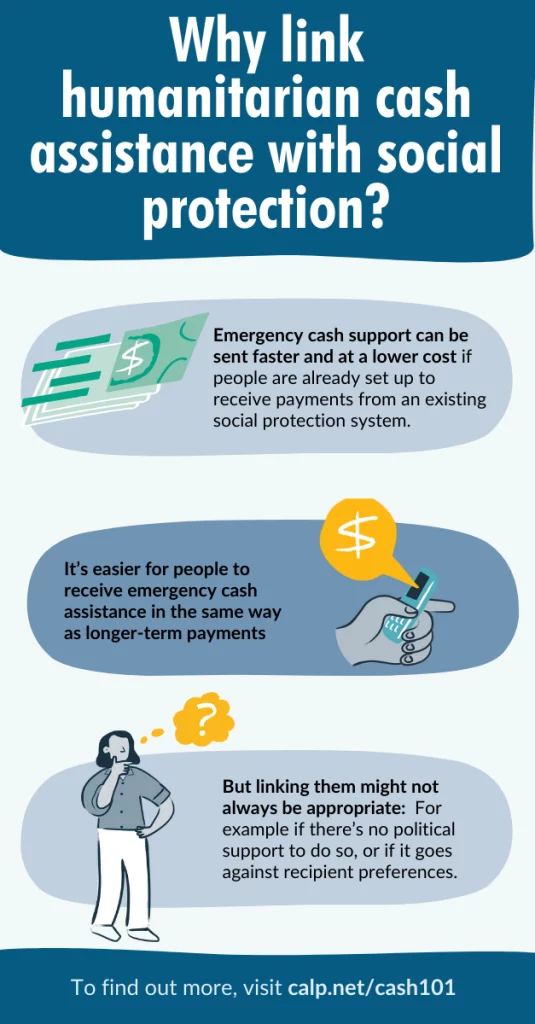Social protection and cash and voucher assistance (CVA)

What is social protection?
Social protection is commonly understood as a set of policies and programmes aimed at preventing or protecting all people against poverty, vulnerability, and social exclusion throughout their life. The definition of social protection might vary by organisation or be influenced by political perspectives.
Examples include:
- Child grants for school meals or education.
- Pensions for older people.
- Programmes addressing specific vulnerabilities.
- Access to health, education, and social services, such as refuges for women or children’s homes.
- Financial support during times of pandemics or natural hazards.
Who provides it?
Generally, social protection is led by state actors but might be supported by national or international partners in some countries. Where states are weak or in conflict, non-governmental humanitarian agencies may step in to provide longer-term services that would normally be part of social protection systems.
How does cash and voucher assistance relate to social protection?
Links between social protection and humanitarian response have been heralded as a means of responding to increasingly complex and protracted crises, while addressing underlying poverty, building resilience and supporting the localisation of humanitarian action. Big policy commitments, such as the Grand Bargain, have highlighted that the delivery of CVA should, if possible and appropriate, link with social protection mechanisms.
But what do these linkages look like in practice?
Depending on the maturity of the system in the response context, linkages can mutually benefit both humanitarian and state actors.
For example when social protection systems:
- Are mature: Humanitarians can play a support role, such as enhancing accountability and collecting evidence.
- Still needs to be strengthened: CVA programmes can support expansions during a crisis, piggyback off the existing system, and collaborate with the government on preparedness activities.
- Exist but are very weak: Humanitarians can help to keep social transfers running and leverage functional components of the system to deliver humanitarian CVA at scale.
- Don’t exist: Humanitarians can help set up building blocks, such as a recipient registry, payment mechanisms and coordination mechanisms.
Linking CVA and social protection might not always be possible or appropriate. A number of conditions need to be in place to establish links, such as political acceptance of forming linkages with humanitarian programming and recipient preference for cash support.

Keep up to date with this topic on CALP’s Social Protection theme page or download the SP Toolbox.
Examples of social protection and CVA
- The EU-funded Emergency Social Safety Net (ESSN) in Türkiye for 1.5 million refugees is one of the biggest examples of a social protection system providing humanitarian cash transfers. The programme uses Türkiye’s established national systems, and pays each family member 155 Turkish Lira per month to cover essential needs like rent, transport, bills, food and medicine. The ESSN has achieved a sharp decline in poverty, as well as an increase in food consumption.However, the programme has attracted controversy due to the freedom of movement conditions attached to this support.
- Missed opportunity in Ukraine: Ukraine has an established, mature and digitised social protection system, which had experience of scaling up for shocks, such as during the 2014 Russian invasion and the COVID-19 pandemic. Although Ukraine should be a model of how humanitarian CVA can integrate into a mature social protection system, there have been challenges. Parallel systems, teething problems with coordination and a significant proportion of funding going to international over local actors are just some of the issues identified. More on this in this report.
What are the different types of social protection?
Social protection programmes are either classed as ‘non-contributory’, ‘contributory benefits’ or ‘labour market policies’. Humanitarian CVA is normally focused on the non-contributory side, and more specifically on social assistance.
Non-contributory These programmes are financed through government taxation or external aid. Humanitarian CVA or in-kind aid is classified as non-contributory.
Contributory benefits are where people, or someone on their behalf (e.g., their employer), makes a financial contribution on a regular basis so that they can access support when it is needed.
Active labour market policies are labour market measures that have been designed to protect existing jobs and stimulate employment.
Find out more about how CVA links to development on the Cash 101.